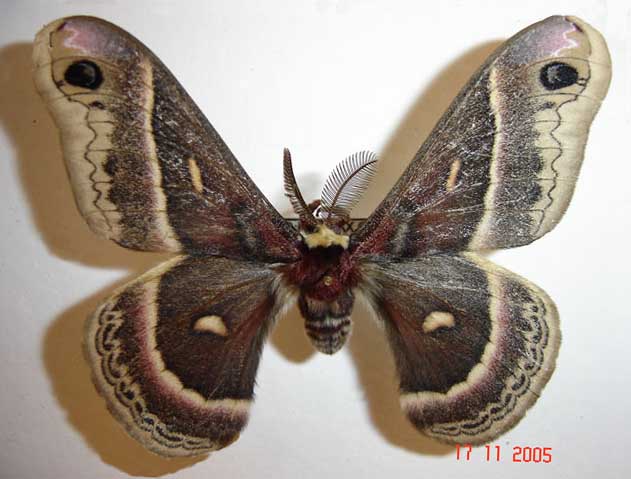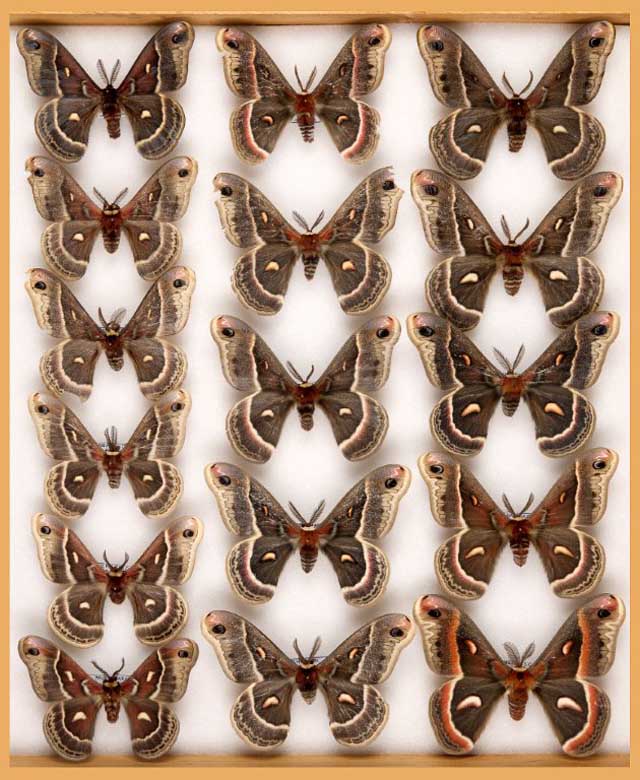Male: Hyalophora columbia x Hyalophora cecropia


Cecropia females often begin calling shortly after dark and most females are paired up before midnight. Females that haven't paired by midnight, stop calling at that time and then begin calling again just at dawn which is the calling time for Hyalophora columbia.
On June 25-26 of 2005, Derek Bridgehouse and I visited Lochaber Mines, Halifax County, Nova Scotia, to do some collecting and to get some females paired with wild males from the area.
Derek was able to take a large sample of male Hyalophora columbia by placing a calling female columbia in a cage in the dark behind our light set up. The female was inaccessable to incoming males, but her pheromones were free to escape through her screened cage.
Among the typical male columbia responding (over fifty of them) was the moth depicted above. It appears to be a wild hybrid, based on the faint red banding on the hindwings. Derek indicates its appearance is notably different from typical male columbia, but the size is that of typical male columbia.
For the last seventeen years Nova Scotian Derek Bridgehouse and I have been meeting in Sheet Harbour to do some late June collecting. This year we will be in Malay Falls and Lochaber Mines (near Sheet Harbour) June 27-28.
Derek writes, "Find attached a nice pic of last seven years of our annual trip to Malay Falls depicting (proposed columbia X cecropia) hybrids.
"I have vouchered and examined fourteen male Hyalophora hybrid specimens. Figure 1 shows the range of phenotypes collected at the Eastern Shore locale of Malay Falls. All males dorsal view. Specimen top left resembles "typical" columbia, that lower right resembles "typical" cecropia. Intervening specimens exhibit a complex of wing characters from both parental phenotypes.
"These specimens indicate integration of characters otherwise diagnostic for the two species, such as hindwing discal spot shape, red scaling on upper wing surface, and coloration. The predominant characteristic of a columbia-cecropia hybrid is the presence of any red scaling beyond the white PM band (all specimens appear to show some degree of this – upon my observation ) ?
"Thought you might find this interesting after all our pursuits the last few years. That’s why I appreciate you finding and saving any potential hybrids for me from your PEI lights and friends looking out for you on the Island.
"I appreciate your thoughts on the pic and specimens.
"I always look forward to our Annual Sheet Harbour Moth Roundup. I pray for a good spring 2014 to go collecting and hang the MV light & sheets"

Hyalphora cecropia/columbia hybrids, Malay Falls, Nova Scotia,
courtesy of Derek Bridgehouse.
I have personally witnessed and reared offspring of pairings of Hyalophora cecropia females with Hyalophora columbia males. I have also witnessed in the very early morning hours a male cecropia flying around a caged female columbia. I cannot rememebr if they paired, but I suspect there are natural hybrids on the go that has resulted from both fertilization of females of cecropia and columbia. Some of the variation seen above may be from the two different types of gender hybrids.
Although female hybrids are barren, ie, do not carry any developed eggs, the male hybrids are supposedly reproductively viable and this may result in many intergrades in a hybrid zone such as we have in the Maritime Provinces of eastern Canada and probalby in southern Quebec and Ontario.
My recollection is that the weak red hindwing post median line of male hybrids is often more discernable on the ventral surface than on the dorsal surface. The male hybrids also tend to intermediate in size between cecropia and columbia.
I once took a wild female hybrid at lights near Saint John, New Brunswick. She totally lacked the red banding typical of a female cecropia, but was almost the same size as a cecropia. In pristine condition with a swollen abdomen, I thought she would provide many eggs. When she died several days later without laying any eggs, I opened her abdomen to see what had caused the eggs to be bound. It was then I discovered she was carrying no developed eggs, and subsequent reading advised me this is typical of female hybrids.
Use your browser "Back" button to return to the previous page.